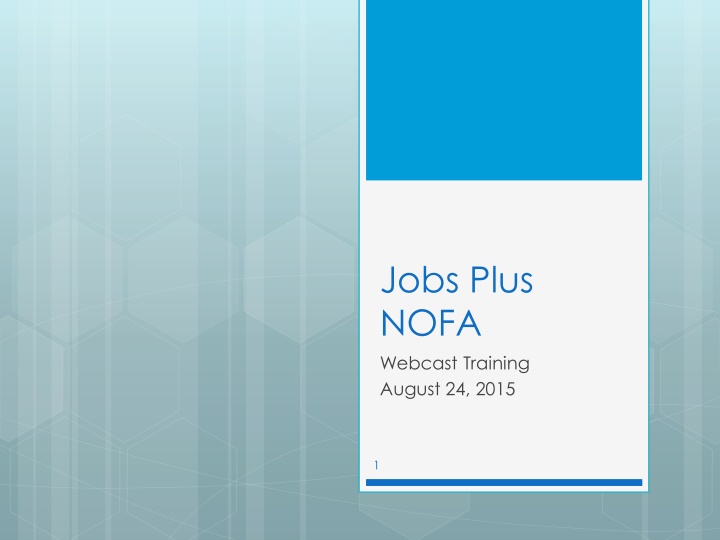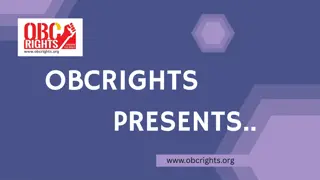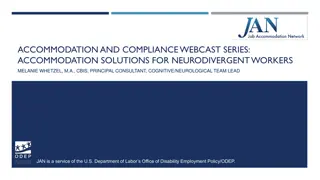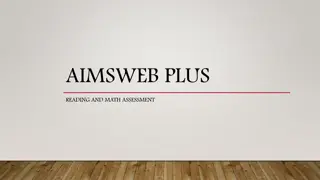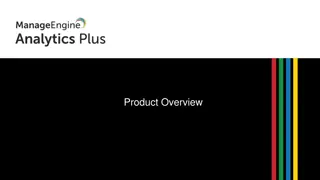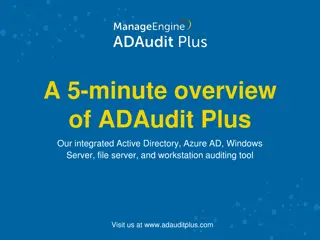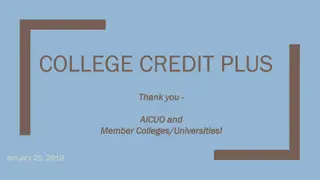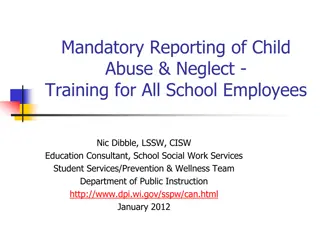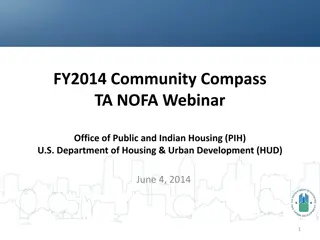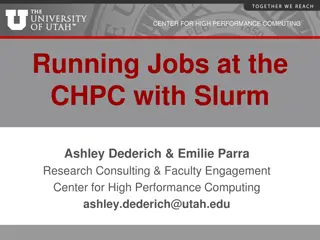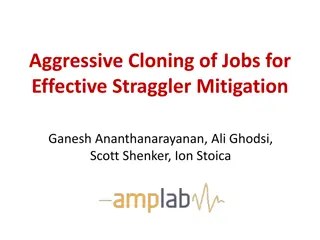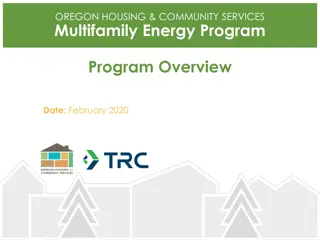Jobs Plus NOFA Webcast Training - August 24, 2015
In this training webcast, important topics such as agenda, due date, eligibility criteria, common mistakes, and specific requirements for the Jobs Plus Model application submission and reporting are covered in detail. Key information on the due date, eligibility for the Jobs Plus Pilot Program, and specific size and unemployment criteria are highlighted. Ensure proper understanding of the criteria and guidelines provided to submit a successful application for the Jobs Plus program.
Download Presentation

Please find below an Image/Link to download the presentation.
The content on the website is provided AS IS for your information and personal use only. It may not be sold, licensed, or shared on other websites without obtaining consent from the author.If you encounter any issues during the download, it is possible that the publisher has removed the file from their server.
You are allowed to download the files provided on this website for personal or commercial use, subject to the condition that they are used lawfully. All files are the property of their respective owners.
The content on the website is provided AS IS for your information and personal use only. It may not be sold, licensed, or shared on other websites without obtaining consent from the author.
E N D
Presentation Transcript
Jobs Plus NOFA Webcast Training August 24, 2015 1
2 Agenda Due Date Eligibility Jobs Plus Model Application Submission Reporting Requirements Appendix A: List of Common Mistakes
3 Agenda (cont.) This webcast will not go over the basics of Grant Applications How to register for and use Grants.gov DUNS/SAM General Section requirements What the due date means/grace period etc. PLEASE READ THE GENERAL SECTION and refer to guidance provided on Grants.gov
4 Due Date Applications are due September 28, 2015 11:59:59 Eastern Time Late applications will not be accepted
5 Eligibility Jobs Plus Pilot Program
6 Criteria for Eligibility Size: Minimum development size of 200 households (excluding elderly- only households) (this is a change from last year) Unemployment: At least 50 percent of the households (excluding elderly-only households) contain no member showing earned income in PIC Place: Because Jobs Plus is a place-based program, units to be served must be contiguous unless good cause can be shown that the program will be successful in non-contiguous developments. A detailed description as to how the program will be run from one central location and remain accessible to all residents of non-contiguous developments will be required in the rating factors. This requirement may disqualify developments on the Eligible Development list if the Asset Management Project (AMP) is for scattered sites. Developments that belong to PHAs that are considered troubled in PHAS or are on the PHARS list or that are in receivership are not eligible to participate. (These developments may still appear in Appendix B)
7 Eligibility - Size HUD makes this determination using PIC data. There must be 200 units in the development that are NOT elderly-only. No distinction for disabled for *eligibility* but please consider this when you are deciding if your development is a good fit for the program The head of household status (elderly or not) does not matter. There must be someone under the age of 65 in the household
8 Eligibility - Unemployment HUD makes this determination using PIC data At least 50 percent of the households (excluding elderly-only households) contain no member showing earned income in PIC
9 Eligibility Developments listed on Appendix B OR Combined Developments that have undergone a Request for Review of Eligibility and have been determined to be Eligible
10 Combining Developments PHAs may propose to combine two or more developments to meet the criteria for eligible developments, subject to the following conditions: Parts of developments cannot be combined. Only entire developments may be combined. The combined developments must meet the criteria for size. The combined developments must meet the criteria for unemployment. If the developments are not contiguous, IN THE FULL APPLICATION, a detailed explanation must be provided of how the program will be run from a central location and remain accessible to all residents.
11 Request for Review of Eligibility Submit a Request via email to JobsPlus@hud.gov. List the development name and numbers from PIC (in the format found in Appendix B) that are proposed to be combined. HUD will review the request using the same query of PIC data on the proposed combined developments to determine if the proposed developments meet the criteria for size and unemployment that was used to generate Appendix B. HUD will respond within five working days of receipt of the request. That response will be an eligibility approval, eligibility disapproval, or a request for more information. If more information is requested, HUD will respond within five working days upon receipt of the additional information. All initial Requests for Review of Eligibility must be received no later than 20 calendar days prior to the due date of this NOFA.
12 Eligibility - Place At least 200 households (excluding elderly-only households) must be located at the site. Units to be served must be contiguous, unless good cause can be shown that a central Jobs Plus center can remain easily accessible to all residents of non- contiguous developments.
13 Jobs Plus Model Jobs Plus Pilot Program
14 Jobs Plus Model 1. Employment-Related Services 2. Financial Incentives - Jobs Plus Earned Income Disregard (JPEID) 3. Community Supports for Work The target population for Jobs Plus are residents who are work-able - people between 18-64 who are mentally and physically able to become employed. The Jobs Plus Pilot Program is not limited to heads of household.
15 Population to be Served The Jobs Plus program must be OFFERED to all residents in the development. Program outreach should be directed towards residents at all points on the employment spectrum from unemployed individuals with no work history, through working (but likely underemployed) families with a substantial work history. Outreach may also be tailored to different audiences within the development(s), including young adults, women, middle-aged adults, parents, older adults, etc.
16 Population to be Served (cont.) The application narrative should include strategies to target this wide range of potential participants, as well as strategies for retention of all types of program participants. (Please note, this is not necessary if the PHA targets a specific sub-group as outlined below) PHA s may plan to target a specific sub-group of residents (e.g. women, young adults, etc.), however a rationale must be provided, including the socio-economic status of the residents within that sub-group and the specific needs of the sub-group. Even if a sub-group is targeted, Jobs Plus must be offered to all residents.
17 Highlight of HUD/DOL Joint Partnership Partnership Toolkit and Webinar: From the Ground Up http://www.doleta.gov/youth_services/tech_assistance.cfm Promise Zones: Access to resources and expertise for communities most in need http://portal.hud.gov/hudportal/HUD?src=/program_offices/co mm_planning/economicdevelopment/programs/pz HUD/DOL YouthBuild Section 3 Guidance: http://portal.hud.gov/hudportal/documents/huddoc?id=HUD- DOL_Factsheet.pdf
18 Jobs Plus Model Employment-Related Services Successful applicants must partner with the Department of Labor Workforce Investment Boards (WIBs)/American Job Centers (AJCs)/One-Stops PHAs are not required to partner with WIBs/AJCs exclusively, but an MOU with the WIB/AJC is a threshold requirement in order to be considered for funding.
19 Jobs Plus Model Employment-Related Services Program services provided on site should include but need not be limited to the following: Career exploration/job readiness workshops Job search and job placement assistance Work experience including on-the-job training, internships and pre- apprenticeships and Registered Apprenticeships Facilitated connections to education and training opportunities Rapid re-employment assistance in the event of job loss Proactive post-placement job retention support and career advancement coaching Access to computers, phones, fax, and copy machines and other supplies, for participants employment-related uses as well as adequate training on how to use these technologies.
20 Partnerships HUD expects that all services that are generally available to residents of the community will be leveraged in-kind from partners. Grant funds should only be used to procure services that are not already available (either by service type or amount).
21 Jobs Plus Model - JPEID All targeted residents in a Jobs Plus development are eligible to receive the JPEID benefit, but they must sign up for the JPEID, even if they do not actively participate in other Jobs Plus activities. SIMILAR TO EID, but MODIFIED Residents who previously used up some or all of their lifetime EID eligibility are eligible to receive the full JPEID benefit. The JPEID is in effect for a continuous period of the Jobs Plus grant, beginning when a participant first increases earned income over baseline (no stop/start) The JPEID excludes 100 percent of incremental earned income for the entire period of the Jobs Plus program (no 50%/100%)
22 JPEID In your application budget, you are required to estimate how much of the grant funds you will need in order to reimburse yourself (the PHA) for rental income lost due to the JPEID. THRESHOLD: JPEID may NOT total more than 60% of the total grant funds requested. (This is due to the eligible uses of grant funds it does NOT mean that you SHOULD request 60% for JPEID.) To facilitate reimbursements for rent revenue losses due to the JPEID, grantees must calculate and document a participants Family Rent both with and without the JPEID and be able to provide these calculations to HUD as a requisite for drawing reimbursement funds. The difference between the two amounts is the value of the JPEID. Grantees should expect to use the JPEID model of rent incentive as described in the NOFA. Whether other rent incentive models (FSS, rent reform, MTW) may be layered will be determined on a case-by-case basis with grantees.
23 Jobs Plus Model Community Supports for Work Leadership, resident participation and empowerment and building relationships between residents and from the development into the community that will lead to sustained support for work during and beyond the period of the Jobs Plus program A robust engagement strategy for involving the residents of the targeted development is critical. Engagement is more than signing up. Creating a working community requires sustained involvement in the program and ultimately ownership of the program, yielding continued benefits for both participants and future residents of the development beyond the grant period. Community Coaches will serve as intermediaries between the program and the community and serve an important role in building community support.
24 Application Submisson Jobs Plus Pilot Program
25 Changes from FY 2014 NOFA Project Map is no longer a threshold requirement but is still required in the application. MOU must be signed and dated between NOFA issue date and application due date While many rating factor scores are similar, some have been combined and/or revised and score values have been adjusted A standard file naming convention has been implemented Only the information contained within the page limits for each narrative will be used for scoring that narrative.
26 Application Format Application components are: Executive Summary Narratives for Rating Factors 1-3 Map of Site Signed MOU between PHA and WIB/AJC Implementation Schedule Match Commitment Chart Detailed Match Commitment letters Detailed Program Budget Jobs Plus Summary Budget Budget Narrative Please follow the directions in the NOFA with regard to naming convention and file order Narrative page limits assume 12 page fonts, double spaced with one inch margins
27 Thresholds Eligibility Memorandum of Understanding (MOU) between PHA and WIB/AJC/One-Stop, signed between the date of publication of the NOFA and the application due date Match of at least 25% of requested grant funds No more than 60% of requested grant funds for JPEID
28 MOU Applicants must establish and maintain a working relationship with local Workforce Investment Board and/or local American Job Center (formerly known as One-Stop Center). Documentation of this relationship should be submitted in the form of a Memorandum of Understanding (MOU) between the Housing Authority and the local Workforce Investment Board or American Job Center/One-Stop Center. The MOU must identify roles and responsibilities of the signatory agencies. The MOU must be signed by both parties, and dated between the publication of the NOFA and the application due date If there is an MOU already in place, the parties must execute an Addendum that specifically references the Jobs Plus Program, and meets the date requirements
29 Rating Factor 1 Capacity (up to 15 pages) Team Make-Up, Roles/Responsibilities (up to 8 points) Roles/responsibilities & knowledge/experience of staff in planning, managing, implementing in accordance with the implementation schedule Past Performance with Similar Programs (up to 8 points) Experience and capacity with multi-year programs, multiple sources of funding, and collaboration of many partners Managerial, technical, administrative capability to implement evidence-based strategies Recent, relevant experience in employment training and/or resident engagement (include joint initiatives between the PHA and WIB/AJC)
30 Rating Factor 1 Capacity (cont.) Capacity to operate a place-based, community focused program (up to 8 points) Map of proposed site Description of place-based community Description of facilities and role as the center of the community If site is not contiguous, details on how the program will be easily accessible to all residents
31 Rating Factor 1 - Capacity Section 3 (up to 5 points) PHA s Section 3 initiatives and results over past 5 years Innovative approaches Hiring, retention beyond initial project Training opportunities provided & notification How will you connect participants with employment? What incentives will be offered to employers? How will contractors be monitored for compliance? Working with Residents (up to 5 points) Experience working with residents as team members and leaders, including traditional resident councils as well as other experience.
32 Rating Factor 2 Need (up to 5 pages) Socio-economic and demographic description of residents residing at the target site (up to 2 points) Number of work-able adults (work-able = 18-64 and mentally and physically able to become employed) Current rate of unemployment Rationale if targeting a specific sub-group (women, young adults, etc.)
33 Rating Factor 2 - Need Other programming the PHA has been operating to provide employment-related services (up to 2 points) Goals and outcomes How Jobs Plus will enhance or replace existing programming Description of local employment market (up to 2 points) Number and types of jobs available. Skills residents must have in order to pursue in-demand jobs (including education/training required) Barriers faced by residents
34 Rating Factor 3 Soundness of Approach Program Activities and Implementation Plan (max 20 pages) Outreach and Engagement (up to 8 points) How will residents be recruited? How will you outreach to those least likely to participate? What retention methods will be employed? Goals for outreach touches and enrollments
35 Rating Factor 3 Soundness of Approach Career/Employment/Training Services (up to 14 points) What services will be offered and by whom? What supportive services will be offered, and how will they change and adapt over time? What special efforts will be made to help least likely to succeed? Not only employed, but move toward living wage/benefits that might enable housing self-sufficiency? Establish and maintain relationships with local employers to create employment and work-based learning opportunities & hold employers accountable for longevity/advancement? Employer engagement strategy? Specific commitments employers are making Key outcome goals including % employed % increase in quarterly employment rates % increase in # of residents increasing earned income % increase in $$ amount of increase
36 Rating Factor 3 Soundness of Approach Specific Goals (up to 4 points) How will financial empowerment/coaching be included in the program design? How will computer/digital literacy be included in the program design?
37 Rating Factor 3 Soundness of Approach Financial Incentives/JPEID (up to 6 points) How with you administer and implement JPEID? How will you work with your accounting/rent calc and/or on-site managerial staff to ensure all understand and value JPEID? How will you explain JPEID to residents and encourage program participation? How will you track the impact of JPEID on rental income? Projected number of residents (actively participating in Jobs Plus and only enrolled in JPEID) accessing JPEID Projected dollar amount to be expended on JPEID
38 Rating Factor 3 Soundness of Approach Community Supports for Work (up to 12 points) Your vision for Community Supports for Work How will residents be hired, trained and employed as Community Coaches? What role will partners play in Community Supports for Work? How will you involve residents who are not Community Coaches? What innovative features will you implement? List proposed outcomes and goals for this aspect of the Jobs Plus program
39 Rating Factor 3 Soundness of Approach Program Schedule (up to 4 points) (Up to 5 pages) Program schedule in any format of your choosing documents activities, timeframes, deliverables, key partners requires to implement the strategies described in the narrative Timeframes for start-up activities to ensure no more than 6 months
40 Rating Factor 3 Soundness of Approach Detailed Budget (in your own format - no page limit) (up to 2 points) Summary Budget (use provided form HUD-50144) (up to 2 points) Budget Narrative (up to 5 pages) (up to 4 points) Specific activity costs Costs related to program administration Salaries program planning TA JPEID (no more than 60% of total grant funds requested) Other costs Should reflect both grant funds and match/leverage THE 60% MAX for JPEID is due to statute/appropriations. DO NOT interpret that HUD expects 60% of grant funds to go to JPEID.
41 Jobs Plus Summary Budget Summary Jobs Plus Budget Uses Sources Year 1 Year 2 Year 3 Year 4 Total Grant Funds Requested Match/ Leverage Funds/ In- Kind Total Jobs Plus Funds (to be completed by HUD) ROSS Funds (to be completed by HUD) $0.00 $0.00 $0.00 $0.00 20XX Salaries/Fringe 20XX Technical Assistance/ Consultants 21XX Travel 21XX Training/Conferences 21XX Administrative 21XX Data Systems/Software 21XX Rent/Financial Incentives 21XX Services Total $0.00 $0.00 $0.00 $0.00 $0.00 $0.00 $0.00 $0.00 $0.00 $0.00 $0.00 $0.00 $0.00 $0.00 $0.00 $0.00 $0.00 $0.00 $0.00 $0.00 $0.00 $0.00 Leverage (to be verified by HUD) #DIV/0! Form will total across and down as you add figures Grant Funds Requested should not total more than $3 million Total Uses and Total Sources should match up for each line and overall. The purple box will calculate total match/leverage divided by total grant funds requested for a leverage percent. This figure will be re- calculated after all match/leverage letters have been reviewed for adherence to requirements Grey columns will be completed by HUD upon award
42 Rating Factor Match/Leverage Minimum 25% verified by match commitment letters is required to be considered for funding. More will result in up to 4 points for leverage Leverage Ratio Points Awarded 1:1.5 or higher 1:1.25 and 1:1.49 1:1 and 1:1.24 1:0.75 and 1:0.99 Less than 1:0.25 4 3 2 1 0
43 Rating Factor Match/Leverage HUD expects that all services that are generally available to residents of the community will be leveraged in-kind from partners. Grant funds should only be used to procure services that are not already available (either by service type or amount). Include a Match Commitment Chart (cover sheet) to this rating factor that lists the partners, a description of the service to be provided and the amount. Agency Brief Description of Cash/In-Kind to be Provided Amount of Match/Leverage Q Agency Y Agency Total Adult Literacy Asset Building and GED $120,000 $50,000 $170,000
44 Rating Factor Match/Leverage Match/Leverage Letters READ THE REQUIREMENTS Match/leverage must be firmly committed - amount of match resources and their dedication to Jobs Plus funded activities must be explicit, in writing on letterhead, and signed by a person authorized Must be dedicated to Jobs Plus participants Must indicate the total dollar value of the commitment and show how that dollar value was determined For match based on participants served, the calculation should be: __residents x __ cost of program per resident per year x __ years of grant = total commitment For match based on staff/volunteer time, the calculation should be: __ hours per year x __ hourly rate x __ years of grant = total commitment For match based on a set resource, the calculation should be: __ monthly rate x __ months per year x __ years of grant = total commitment
45 Rating Factor Match/Leverage (cont.) Match/Leverage Letters READ THE REQUIREMENTS (cont.) Must explain what will be provided and how it will relate to the proposed program May not be contingent on future funding from any source (including federal) (e.g. If we get X grant we will dedicate $$ to Jobs Plus. or If we receive our usual annual allotment from X federal agency, we will dedicate $$ to Jobs Plus. ) MAY say e.g. IF this application is successful, we will dedicate $$ to Jobs Plus program. Must be on agency letterhead and signed by an authorized person Must be dated between July 29, 2015 and September 28, 2015 If commitment is from the PHA applicant itself, must also have a letter that indicates all of the above and source of funding.
46 Rating Factor Match/Leverage Supportive services resources may include, but are not limited to, the following. All must be related to the activities of the Jobs Plus program. The value of a building or space in a building donated for Jobs Plus purposes; The value of a lease on a building or space in a building donated for Jobs Plus purposes; Other infrastructure for Jobs Plus purposes; Time and services contributed by volunteers; Staff salaries and benefits of service providers (PHA staff time may not be counted); The value of supportive services provided by a partner agency TANF. TANF cash benefits (for individuals) will not be accepted as a resource for leverage. Non-cash services provided by TANF agencies may be accepted as a resource for leverage. Wages projected to be paid to residents through jobs or projected benefits (e.g. health/insurance/retirement benefits) related to projected resources to be provided by the Jobs Plus program may not be counted. Other than language in the NOFA, HUD does not express a legal opinion on the eligible uses of other federal agencies program funding. Each applicant is responsible to ensure, with their partners, that the committed funding is eligible for the committed use.
47 Bonus Points HUD encourages activities in communities with Preferred Sustainability Status (PSS) and/or Promise Zones (PZ). HUD will award two (2) points for qualified activities supporting either designation or both. (2 points max) See p.22-23 of General Section for requirements
48 Other Forms HUD-2991 Certification of Consistency with Consolidated Plan will be reflected in grantees future PHA Plan revisions. No requirement for application submission
49 Reporting Requirements Jobs Plus Pilot Program
50 Reporting Requirements/ Program Evaluation Quarterly report with specific program outputs and metrics (TBD) Grantees will be required to track residents participation in program services and provide individual and aggregate reports to HUD and should include in their partnership agreements mechanisms to obtain information critical to this tracking from partner agencies. Annual narrative report in standardized format TBD, plus SF-425 (federal financial report) and HUD-27061 (racial and ethnic data) Participate in HUD-sponsored evaluation
